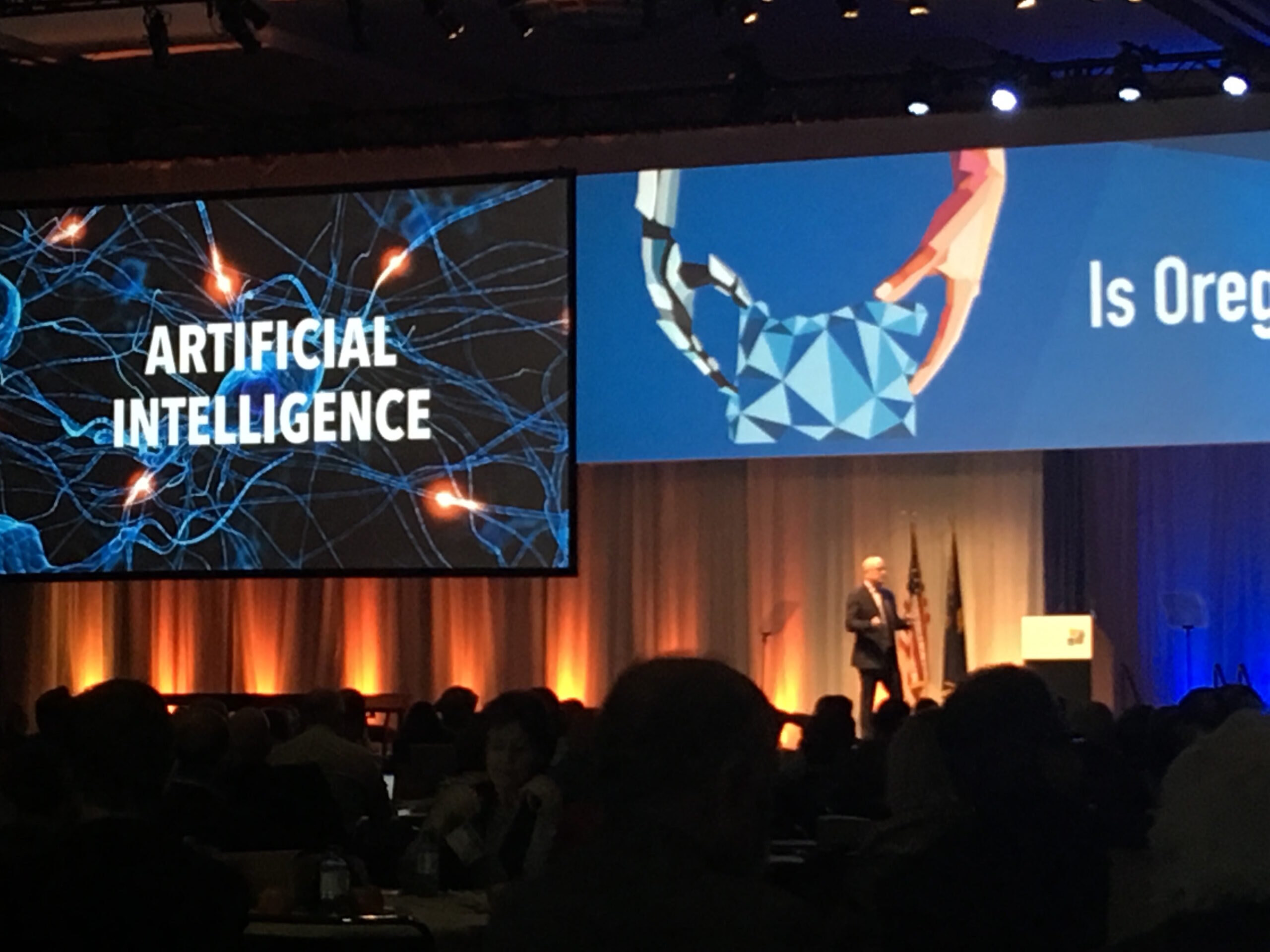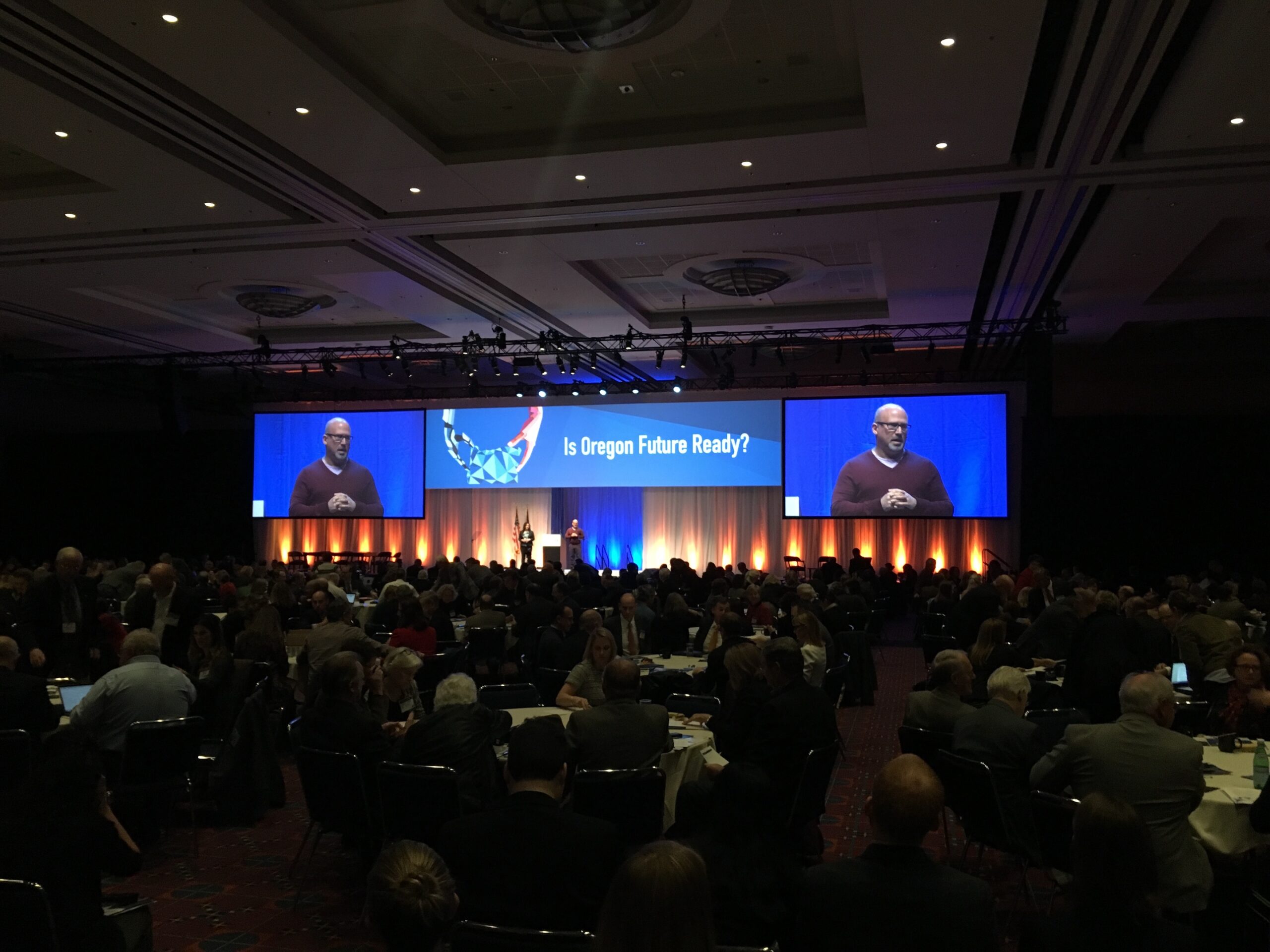The 15th annual Oregon Leadership Summit yesterday brought together business and political leaders for a discussion about the state’s economic future.
The speeches and conversations added up to a series of dire warnings, tinged with just enough optimism to keep people in their seats. Oregon faces a budget crisis. Robots are coming for our jobs. The epic 2017 fire season won’t be our last.
Here are three issues that keep Oregon business leaders up at night:
Tillamook’s Patrick Criteser at #olsummit: No crisis looms as large as Oregon’s fiscal crisis. @PDX_BizAlliance pic.twitter.com/7LSxeN6HcL
— Sandra mcDonough (@Sandimcdpdx) December 4, 2017
We’re already behind schedule on the budget crisis
The PERS crisis loomed large.
“We need to act now to avoid the Antietam of Oregon politics,” said Oregon Business Plan chair Patrick Criteser, comparing the budget crisis to a Civil War bloodbath. The newly elected president of Oregon Business & Industry, Representative Mark Johnson, added, “the longer we wait, the bigger the hole gets.”
 Sen. Jeff Merkley speaking at the morning session
Sen. Jeff Merkley speaking at the morning session
Legislators and business leaders pointed to HB 2017, the $5.3 billion state transportation package as an example of bipartisan action. They called for bringing unions, industry groups and politicians to the table as quickly as possible — although no one provided details about what would be discussed at the table. Gov. Kate Brown went one step further: She said her plan would focus on incentivizing local employers to pay down their unfunded actuarial liability and setting up risk-sharing programs for employees.
For Oregon’s future, @OregonGovBrown wants to focus on investing in rural communities, water, affordable housing and broadband infrastructure throughout the state, continuing work in innovation, cross laminated timber (CLT), workforce training and small businesses. #OLSummit pic.twitter.com/sxBZZKXUZk
— PDXBusinessAlliance (@PDX_BizAlliance) December 4, 2017
Despite the success of HB 2017, legislators were not optimistic. Senators Lee Beyer and Brian Boquist, and Representatives Cliff Bentz and Caddy McKeown cringed when an interviewer asked if Oregon could pass a bipartisan revenue package by 2019, saying “we should have started six to eight months ago.”
Gov. Brown added, “I certainly want to get things going, like, last week.”
Automation will affect both white and blue collar jobs
In the afternoon, futurist Steve Brown trained his crystal ball on automation. The key concern, he said, isn’t that robots will take our jobs. It’s that we won’t be able to train people quickly enough for the new jobs the robots create.
“We’ve always created and destroyed jobs with each wave of new technology,” he said. “The danger is that we won’t be able to catch this quickly enough, to shift the people from the old to the new jobs.”
In Oregon, jobs along the coast face the greatest danger of automation, economist John Tapogna told the audience. Coast economies depend on a higher proporation of service jobs, as opposed to Portland’s high number of creative positions.
 Some Oregon small businesses are already using DAX, developed by Oregon-based Nova Dynamics, to make deliveries
Some Oregon small businesses are already using DAX, developed by Oregon-based Nova Dynamics, to make deliveries
Robots like Bossa Nova, which take inventory in grocery aisles, will intensify pressure on the already struggling retail industry, Brown said.
Automation conjures up images of robots on the factory floor and in checkout lines. But Brown reminded the audience that the trend will dramatically restructure white collar jobs as well.
“Your child is more likely to have longevity in a career as a nurse than a doctor,” he said.
 Steve Brown speaking about automation at the Leadership Summit
Steve Brown speaking about automation at the Leadership Summit
Other experts echoed the warning that few jobs are completely robot-proof. Matt Abrams, general partner at Seven Peaks Ventures said, “Every job that has predictable tasks will be affected by automation.”
As we reshape education to meet the automated job market, Brown said, soft skills like creativity and empathy will take on greater importance. You can teach a robot to code, but you can’t teach it how to be human.
Unless state and federal agencies restructure their approach to fire management, large conflagarations will become more common.
Caroline Park, president of Thunder Island Brewing in Cascade Locks, evacuated her home this summer to escape the Eagle Creek fire. She bounced between homes and hotels, she told the audience in a breakout session, and ran payroll from her phone. Her business insurance didn’t cover the first 72 hours of loss—Labor Day weekend.
“The heart of the Gorge shut down,” she said. When your heart stops your whole body feels it.”
 Experts discuss the costs of the 2017 wildfire season
Experts discuss the costs of the 2017 wildfire season
The 2017 wildfire season incurred $438 million in suppression costs, involved 8,000 firefighters, and cost ODOT $300,000 a day in disruptions to traffic. On top of that, businesses lost more than a month of revenue. In a town like Cascade Locks, Park said, with an average income of $26,000, that’s a significant loss.
“The fires are bigger, the fires are hotter,” said Sen. Ron Wyden. “This is unprecedented.”
State Economist Mark McMullen said that based on comparisons to the 1988 Yellowstone fires and the Mt. St. Helens eruption, evidence shows this fire season won’t discourage new business investment in Oregon over the long-run.
John Bailey, a professor at the OSU College of Forestry, argued that the state should spend more on preventative measures like proscribed burns, rather than waiting for a disaster. “Proscribed fire is going to be part of the solution,” he said. “It’s a vaccination.”




